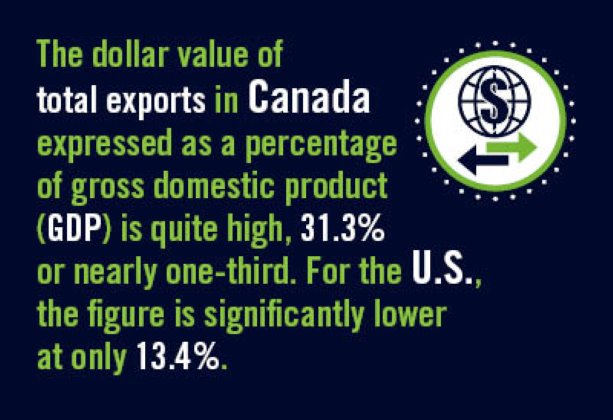Since much of the economic focus this year will be on oil prices and currency shifts, this Economy at a Glance presents several tables that provide background on U.S. and Canadian foreign trade.
Most of the statistics in Tables 1 through 3 won’t come as much of a surprise, but there may be an occasional jaw-dropper that will help you, the reader, see matters in a different light.
Table 1 shows the relative importance of international trade to both countries. The dollar value of total exports in Canada expressed as a percentage of gross domestic product (GDP) is quite high, 31.3% or nearly one-third. For the U.S., the figure is significantly lower at only 13.4%.
The sub-category of ‘goods’ exports includes the kind of trade that includes oil, natural gas and other commodities, plus manufactured products such as cars and airplanes. Canada’s goods exports share of GDP at 26.5% is more than two-and-a-half times as large as America’s 9.3%.
In services exports, the ratios are much closer, 4.8% for Canada compared with 4.1% for the U.S.
Remember there’s an aspect of services exports that’s a little tricky to understand. When foreign tourists come from country ‘B’ to spend money in country ‘A’, those expenditures are considered to be services exports by country ‘A’.
I won’t dwell on imports, since they don’t generate jobs at home. Suffice it to say that Canada’s proportion relative to GDP (32.2%) is again higher than in the U.S. (16.5%), but to a slightly lesser degree than for exports.
Table 2 shows the ‘Top 10’ U.S. exporting states. Almost all of them appear in the ranking because they have large population bases (Texas, California, New York and Washington) and/or they are traditional industrial powerhouses (e.g., Illinois, Michigan, Ohio and Pennsylvania), with well-established firms that have histories of seeking customers outside America’s borders.
Louisiana is on the list thanks to its refineries on the Gulf coast. But what is the state of Washington doing with a ranking that’s a remarkable third overall? It doesn’t take much reflection to discern the answer. Washington is home not only to Boeing in the aerospace sector, but also to a multitude of highly-successful knowledge-based firms (e.g., Microsoft) that are shipping software and hardware around the world.
Finally, we come to Table 3, which looks at exports from Canada’s provinces and regions in key product areas. One of the first statistics to ‘jump off the page’ concerns Alberta. While it may be home to less than 12% of the nation’s population, the province accounted for 24.7% of Canada’s total exports in full-year 2014.
The explanation is easy to find in the next column. Alberta was the source of two-thirds (67.9%) of Canada’s energy exports. (By the way, energy’s share of the country’s total exports was 27.4% last year.)
Ontario, with 38.5% of the nation’s population, was strong in three categories: metals and minerals (48.1%), consumer products (48.7%) and especially vehicles and parts (92.0%).
British Columbia (34.2%) stood out in forestry product exports, although Quebec (26.8%) made a strong second-place showing. Where Quebec really made its mark, though, was in aircraft and parts exports, taking 67.2% of the nation’s total.
Since Bombardier is the cornerstone of that sector in the province, it’s small wonder that the Quebec government has said it will willingly step in to provide financial assistance for the company should it become necessary.
As part of its efforts to bring new aerospace products to market, Bombardier’s debt has been growing alarmingly.
Table 1: Relative Importance of Foreign Trade
U.S. and Canada
(based on latest 12 months)
| Percent of Gross Domestic Product (GDP) | ||
| U.S. | Canada | |
| Exports of goods | 9.3% | 26.5% |
| Exports of services | 4.1% | 4.8% |
| Total exports | 13.4% | 31.3% |
| Imports of goods | 13.7% | 26.2% |
| Imports of services | 2.8% | 6.0% |
| Total imports | 16.5% | 32.2% |
The figures have been pulled from the "current" dollar (i.e., not adjusted for inflation) national output tables.
Data sources: U.S. Bureau of Economic Analysis (BEA) and Statistics Canada / Table: CMD.
Table 2: Origin of U.S. Goods Exports
Top 10 States
(Full year 2014)
| $ Billions | ||
| 1 | Texas | $289.0 |
| 2 | California | 174.1 |
| 3 | Washington | 90.6 |
| 4 | New York | 86.0 |
| 5 | Illinois | 68.2 |
| 6 | Louisiana | 65.1 |
| 7 | Florida | 58.6 |
| 8 | Michigan | 55.8 |
| 9 | Ohio | 52.1 |
| 10 | Pennsylvania | 40.2 |
Falling just short of making the list were Georgia, New Jersey and Indiana.
By far, the leading goods importing states are California and Texas.
Data sources: U.S. Bureau of Economic Analysis (BEA) / Table: CMD.
Table 3: Provincial and Regional Shares of National Total Goods Exports
(Full year 2014)
| Metal & | Forestry | Vehicle | Aircraft & | |||||
| Total | Energy | Mineral | Product | & Parts | Other | Consumer | ||
| Population | Exports | Exports | Exports | Exports | Exports | Transport | Goods | |
| Atlantic | 6.6% | 6.6% | 10.8% | 4.1% | 7.6% | 1.7% | 1.3% | 7.5% |
| Quebec | 23.1% | 15.1% | 2.9% | 24.4% | 26.8% | 4.2% | 67.2% | 21.8% |
| Ontario | 38.5% | 36.1% | 1.6% | 48.1% | 18.3% | 92.0% | 22.7% | 48.7% |
| Manitoba | 3.6% | 2.7% | 1.0% | 2.0% | 1.4% | 1.0% | 3.7% | 4.3% |
| Sask. | 3.2% | 7.1% | 10.0% | 7.9% | 2.1% | 0.1% | 0.0% | 5.5% |
| Alberta | 11.6% | 24.7% | 67.9% | 2.8% | 9.6% | 0.4% | 2.9% | 6.8% |
| B.C. | 13.1% | 7.2% | 5.8% | 7.9% | 34.2% | 0.6% | 2.2% | 5.4% |
| Territories | 0.3% | 0.5% | 0.0% | 2.8% | 0.0% | 0.0% | 0.0% | 0.0% |
| 100.0% | 100.0% | 100.0% | 100.0% | 100.0% | 100.0% | 100.0% | 100.0% |
Data source: Statistics Canada ("customs basis") / Table: CMD.











Recent Comments
comments for this post are closed